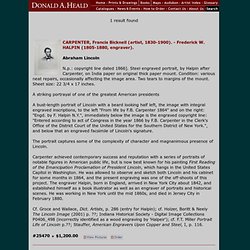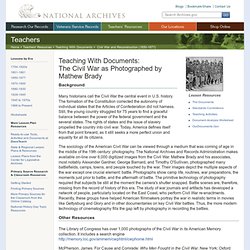

Lincolniana in 1996. Another year in the field of Lincoln scholarship has passed.

Yet, judging from the following bibliography, the scholarship goes on unabated. Not only is Lincoln scholarship maintaining a steady output in the traditional area of print material but it is also expanding into the ever-widening influence of alternative sources. The works of multimedia products now available in CD-ROM format are expanding at a rate greater than any area in Lincoln scholarship except for the Internet. The number of Internet sites now devoted or partially dealing with Abraham Lincoln is amazing. A cursory examination of the Internet using search software reveals over 10,000 documents that use the combination of Abraham Lincoln. This year's "Lincolniana" has expanded to include as many sources as could be identified. Articles "Abe Returns! Book, Video, and CD-ROM Reviews. Lincoln-Related Publications at Making of America. Six months at the White House with Abraham Lincoln. The story of a picture. By F. B. Carpenter.
Donald Heald Original Antique Books Prints and Maps. CARPENTER, Francis Bicknell (artist, 1830-1900). - Frederick W.

HALPIN (1805-1880, engraver). Abraham Lincoln N.p.: copyright line dated 1866]. Steel engraved portrait, by Halpin after Carpenter, on India paper on original thick paper mount. Condition: various neat repairs, occasionally affecting the image area. A striking portrayal of one of the greatest American presidents A bust-length portrait of Lincoln with a beard looking half left, the image with integral engraved inscriptions, to the left "From life by F.B. F.B. Carpenter Engraving of Abraham Lincoln, 1866, - Cowan's Auctions. A Visit from Historian Shelby Foote.
Message Boards - The Legality of Secession in 1860. Secession" Secession, the withdrawal of part of a country or state from the central government's control.

The withdrawal may be carried out peacefully or violently. Political conflicts that lead to secession are usually based on economic, cultural, or religious differences. In United States history the question of secession arose several times before the Civil War, but the term generally refers to the withdrawal of the Southern states from the Union in 1860–61. Secession has also been an issue in other countries. Panama in 1903 seceded from Colombia partly because of Colombian opposition to plans by the United States to construct the Panama Canal. Getting the Civil War Right. Printer-friendly version William Faulkner famously wrote, “The past is never dead.

It’s not even past.” He would not be surprised to learn that Americans, 150 years after the Civil War began, are still getting it wrong. During the last five years, I’ve asked several thousand teachers for the main reason the South seceded. They always come up with four alternatives: states’ rights, slavery, tariffs and taxes or the election of Lincoln. When I ask them to vote, the results—and resulting discussions— convince me that no part of our history gets more mythologized than the Civil War, beginning with secession. My informal polls show that 55 to 75 percent of teachers—regardless of region or race—cite states’ rights as the key reason southern states seceded. These results are alarming because they are essentially wrong. The issue is critically important for teachers to see clearly. James Ostrowski - Lincoln's Secession Arguments. By James Ostrowski* Paper delivered at the first-ever academic conference on secession--"Secession, State, and Economy", sponsored by the Mises Institute, Auburn, Alabama, held at the College of Charleston, Charleston, South Carolina, April 7-9, 1995.

*Member of the bar of New York (1984); Brooklyn Law School (J.D. 1983); State University of New York at Buffalo (B.A. Philosophy, 1980). The author wishes to acknowledge the assistance of Trina Lowmaster (State University of New York at Buffalo, B.A. Political Science, 1994) in the preparation of this article. On May 27, 1861, the army of the United States of America (the "Union")--a nation formed by consecutive secessions, first from Great Britain in 1776, and then from itself in 17881--invaded the State of Virginia,2 which had recently seceded from the Union, in an effort to negate that secession by violent force. The Civil War as Photographed by Mathew Brady. Background.

Civil War Image Map/Battle Maps. Getting the Civil War Right.